
Price :
$215.00
FANTASTIC SEA GRASS LEATHER CLUTCH WITH BAMBOO HANDLE. Featured for summer is a fantastic Joseph sea grass and leather clutch. It has metal zipper closure and pocket. Bamboo More »
FANTASTIC SEA GRASS LEATHER CLUTCH WITH BAMBOO HANDLE. Featured for summer is a fantastic Joseph sea grass and leather clutch. It has metal zipper closure and pocket. Bamboo closure. Label reads Genuine leather made in Brazil. Excellent condition. « Less
|
|
Vintage Clothing & Accessories
|
|
Vendor Details
|
|
| ITEM IS NO LONGER AVAILABLE |
|
|
|
| Vendor Details |
Close |
| Contact Info : |
| Vintage a la Mode |
| 3234 Sacramento Street |
| California-94115 |
| USA |
| Email : decolove@pacbell.net |
| Phone : 415.440.1554 |
|
|
|
|
|
|
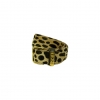
Price :
$235.00
MOSCHINO LEOPARD PRINT ON CALF BELT. Featured is a wonderful Moschino belt. The letters slide. The material is leather/calf leopard print. It is in excellent condition. More »
MOSCHINO LEOPARD PRINT ON CALF BELT. Featured is a wonderful Moschino belt. The letters slide. The material is leather/calf leopard print. It is in excellent condition. Measurements: Waist 32" x 1.25". « Less
|
|
Vintage Clothing & Accessories
|
|
Vendor Details
|
|
| ITEM IS NO LONGER AVAILABLE |
|
|
|
| Vendor Details |
Close |
| Contact Info : |
| Vintage a la Mode |
| 3234 Sacramento Street |
| California-94115 |
| USA |
| Email : decolove@pacbell.net |
| Phone : 415.440.1554 |
|
|
|
|
|
|
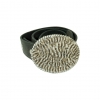
Price :
$250.00
ROBBIE FRENCH DESIGNS QUAIL FEATHER BUCKLE LEATHER BELT sz 34, USA, Featured is a black and white quail feather buckle leather belt by Robbie French Designs. 3.5" x 4.5" More »
ROBBIE FRENCH DESIGNS QUAIL FEATHER BUCKLE LEATHER BELT sz 34, USA, Featured is a black and white quail feather buckle leather belt by Robbie French Designs. 3.5" x 4.5" buckle size 34. « Less
|
|
Vintage Clothing & Accessories
|
|
Vendor Details
|
|
| ITEM IS NO LONGER AVAILABLE |
|
|
|
| Vendor Details |
Close |
| Contact Info : |
| Vintage a la Mode |
| 3234 Sacramento Street |
| California-94115 |
| USA |
| Email : decolove@pacbell.net |
| Phone : 415.440.1554 |
|
|
|
|
|
|
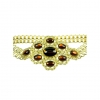
Price :
$275.00
FANTASTIC HUMONGOUS GOLD AND TOPAZ GLASS STONE BELT. Featured is a fantastic gold tone humongous belt with large topaz c colored stones. This belt is fantastic looking on an More »
FANTASTIC HUMONGOUS GOLD AND TOPAZ GLASS STONE BELT. Featured is a fantastic gold tone humongous belt with large topaz c colored stones. This belt is fantastic looking on an all black outfit. Measurements: Buckle with stones: 7.75" x 4.75", End to End 33". « Less
|
|
Vintage Clothing & Accessories
|
|
Vendor Details
|
|
| ITEM IS NO LONGER AVAILABLE |
|
|
|
| Vendor Details |
Close |
| Contact Info : |
| Vintage a la Mode |
| 3234 Sacramento Street |
| California-94115 |
| USA |
| Email : decolove@pacbell.net |
| Phone : 415.440.1554 |
|
|
|
|
|
|
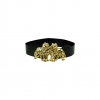
Price :
$215.00
MIMI DI N 1993 DOUBLE LEOPARD 24K GP BELT BUCKLE LEATHER BELT. USA, Featured is a humongous double leopard 24k gold plated leopard buckle with a crocodile leather embossed More »
MIMI DI N 1993 DOUBLE LEOPARD 24K GP BELT BUCKLE LEATHER BELT. USA, Featured is a humongous double leopard 24k gold plated leopard buckle with a crocodile leather embossed belt. It is signed and dated 1993. It is in excellent condition. Measurements: Leopard 3" x 3", Belt up to 40". « Less
|
|
Vintage Clothing & Accessories
|
|
Vendor Details
|
|
| ITEM IS NO LONGER AVAILABLE |
|
|
|
| Vendor Details |
Close |
| Contact Info : |
| Vintage a la Mode |
| 3234 Sacramento Street |
| California-94115 |
| USA |
| Email : decolove@pacbell.net |
| Phone : 415.440.1554 |
|
|
|
|
|
|

Price :
$350.00
VINTAGE 1970 PURPLE SUEDE HUMONGOUS BRASS BUTTERFLY BELT. Featured is a fantastic purple suede belt with humongous brass butterfly circa 1970's . It is in excellent More »
VINTAGE 1970 PURPLE SUEDE HUMONGOUS BRASS BUTTERFLY BELT. Featured is a fantastic purple suede belt with humongous brass butterfly circa 1970's . It is in excellent condition. Measurements: 32" x 4". « Less
|
|
Vintage Clothing & Accessories
|
|
Vendor Details
|
|
| ITEM IS NO LONGER AVAILABLE |
|
|
|
| Vendor Details |
Close |
| Contact Info : |
| Vintage a la Mode |
| 3234 Sacramento Street |
| California-94115 |
| USA |
| Email : decolove@pacbell.net |
| Phone : 415.440.1554 |
|
|
|
|
|
|
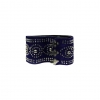
Price :
$195.00
HUMONGOUS PURPLE SUEDE SILVER STUDDED HOOKS BELT. Featured is a fantastic purple suede silver studded humongous belt by Saks Fifth Avenue. It is in excellent condition. More »
HUMONGOUS PURPLE SUEDE SILVER STUDDED HOOKS BELT. Featured is a fantastic purple suede silver studded humongous belt by Saks Fifth Avenue. It is in excellent condition. Measurements: 31" x 5". « Less
|
|
Vintage Clothing & Accessories
|
|
Vendor Details
|
|
| ITEM IS NO LONGER AVAILABLE |
|
|
|
| Vendor Details |
Close |
| Contact Info : |
| Vintage a la Mode |
| 3234 Sacramento Street |
| California-94115 |
| USA |
| Email : decolove@pacbell.net |
| Phone : 415.440.1554 |
|
|
|
|
|
|
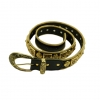
Price :
$275.00
HEAVY DUTY ORNATE GOLD TONE MEDALLIONS & LEATHER BELT. Featured is an incredible heavy duty ornate gold belt with gold medallions and mesh trim on genuine leather. Excellent More »
HEAVY DUTY ORNATE GOLD TONE MEDALLIONS & LEATHER BELT. Featured is an incredible heavy duty ornate gold belt with gold medallions and mesh trim on genuine leather. Excellent condition. Measurements: 36"waist x 1". « Less
|
|
Vintage Clothing & Accessories
|
|
Vendor Details
|
|
| ITEM IS NO LONGER AVAILABLE |
|
|
|
| Vendor Details |
Close |
| Contact Info : |
| Vintage a la Mode |
| 3234 Sacramento Street |
| California-94115 |
| USA |
| Email : decolove@pacbell.net |
| Phone : 415.440.1554 |
|
|
|
|
|
|

Price :
$225.00
VINTAGE 1950 AUTUM COLOR FEATHER & SATIN HAT. USA, Featured is a very wonderful autumn color feather and satin hat. It is made by Maison Mendessolle, San Francisco. Fits More »
VINTAGE 1950 AUTUM COLOR FEATHER & SATIN HAT. USA, Featured is a very wonderful autumn color feather and satin hat. It is made by Maison Mendessolle, San Francisco. Fits across the head 10". « Less
|
|
Vintage Clothing & Accessories
|
|
Vendor Details
|
|
| ITEM IS NO LONGER AVAILABLE |
|
|
|
| Vendor Details |
Close |
| Contact Info : |
| Vintage a la Mode |
| 3234 Sacramento Street |
| California-94115 |
| USA |
| Email : decolove@pacbell.net |
| Phone : 415.440.1554 |
|
|
|
|
|
|

Price :
$285.00
JACK MCCONNELL BOUTIQUE BURGUNDY PINK GOLD HAT. USA, Featured is a wonderful burgundy pink, gold and round coil applique with black sticks hat. It is in excellent condition. More »
JACK MCCONNELL BOUTIQUE BURGUNDY PINK GOLD HAT. USA, Featured is a wonderful burgundy pink, gold and round coil applique with black sticks hat. It is in excellent condition. Measures: 22". « Less
|
|
Vintage Clothing & Accessories
|
|
Vendor Details
|
|
| ITEM IS NO LONGER AVAILABLE |
|
|
|
| Vendor Details |
Close |
| Contact Info : |
| Vintage a la Mode |
| 3234 Sacramento Street |
| California-94115 |
| USA |
| Email : decolove@pacbell.net |
| Phone : 415.440.1554 |
|
|
|
|
|
|


